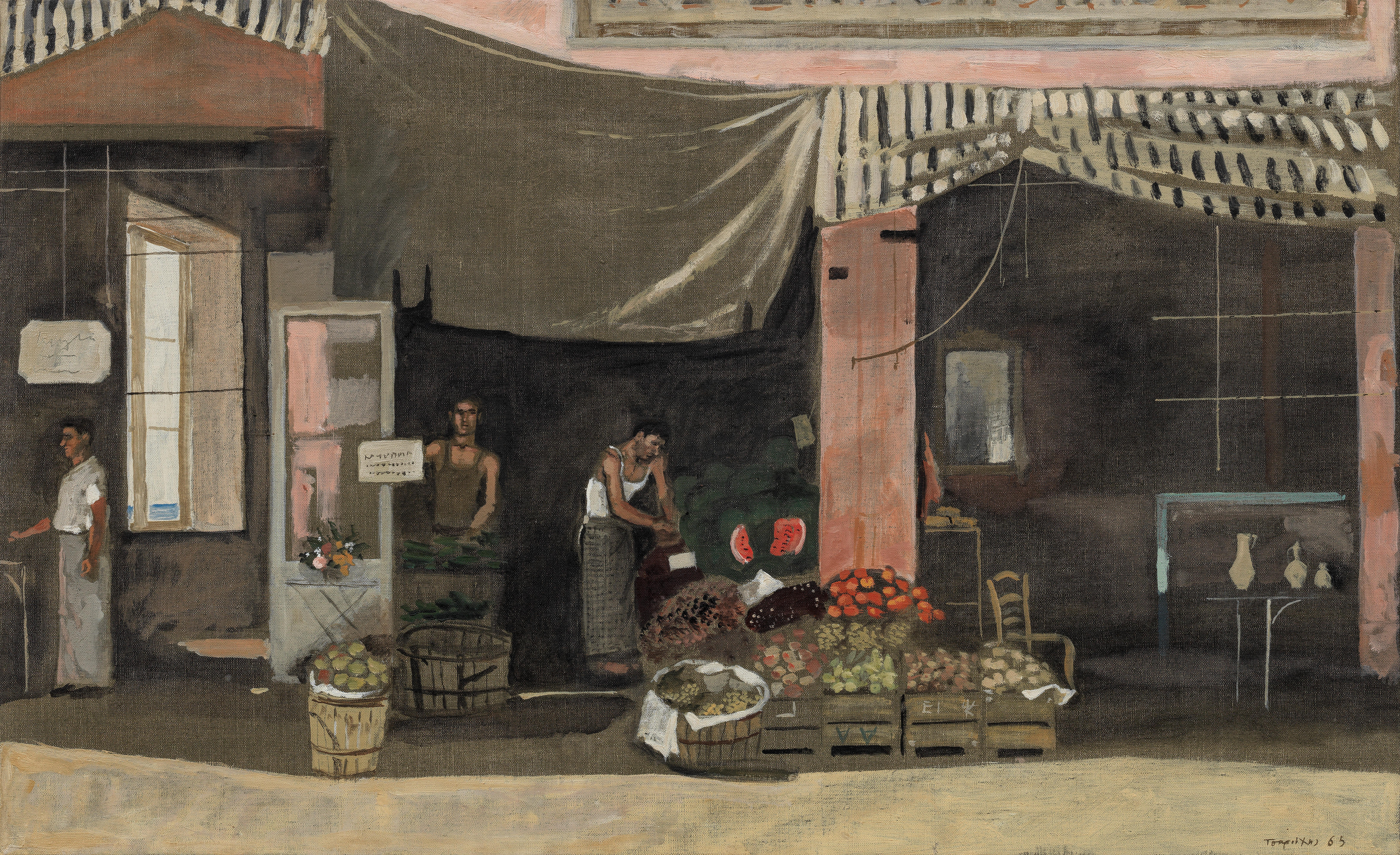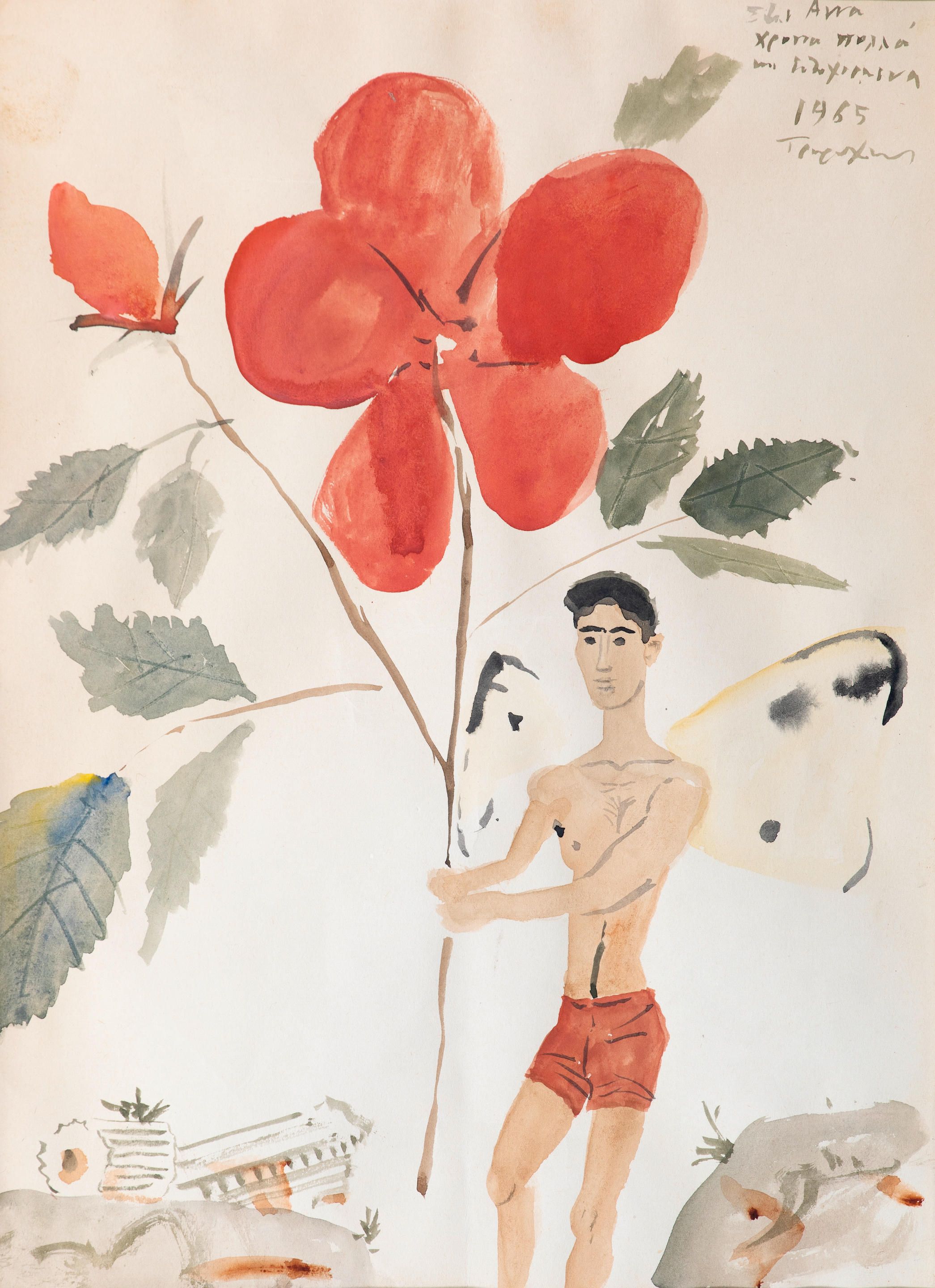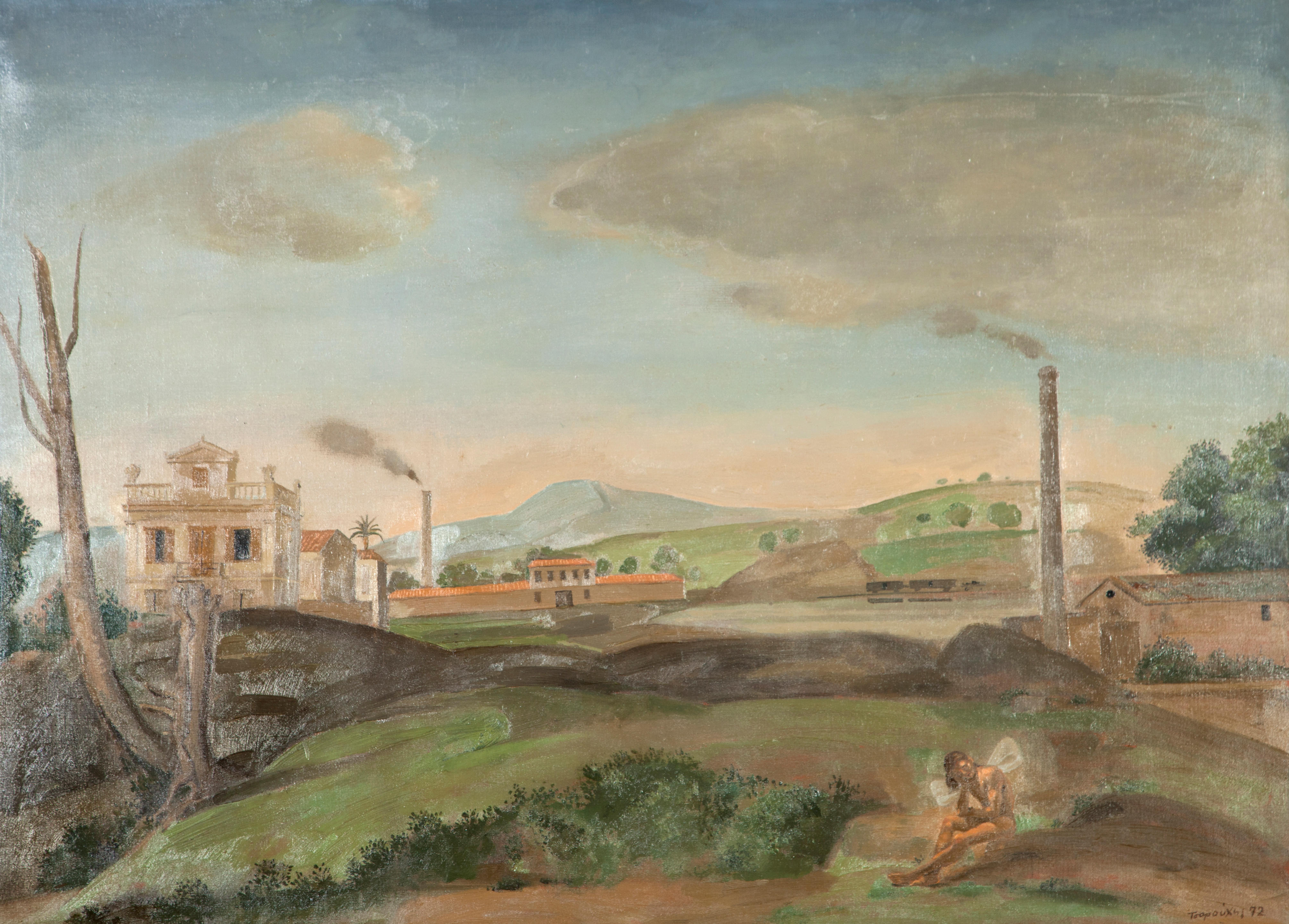Yiannis Tsarouchis (Greek, 1910-1989)La garde oubliée signé en grec et daté '1955' (en bas à gauche) huile sur toile 40.5 x 56cm (15 15/16 x 22 1/16in). signed in Greek and dated (lower left) oil on canvasFootnotesProvenance Brooks Jackson - Iolas Gallery, New York. Alexander Iolas collection. Acquired from the above by the present collection. Littérature Architektoniki magazine, no. 56, March-April 1966, p. 106 (illustrated). The Greek Painters, vol. II, 20th Century, Melissa editions, Athens 1975, p. 299 (mentioned). T. Spiteris, Three Centuries of Modern Greek Art 1660-1967, Athens 1979, vol. II, p. 211 (illustrated). Y. Tsarouchis, Os Strouthion Monazon epi Domatos, Kastaniotis editions, Athens 1987, p. 42 (mentioned). Yannis Tsarouchis (1910-1989) Painting, Yannis Tsarouchis Foundation, Athens 1990, p. 65 (mentioned), p. 59, fig. 54 (illustrated). Ioannis Tsarouchis by Alexios Savakis, Kastaniotis editions, Athens 1993, p. 148 (mentioned). Formerly in the collection of legendary Alexander Iolas1, this fine jewel painted at the height of the artist's creative powers, is a groundbreaking work2 that encompasses the defining elements of the so-called Tsarouchian universe, including the sailor—his signature subject and one of the most celebrated images of 20th century Greek art—the male nude, the coffeehouse, the stage-like design, the flower still-life, the mirror, and the dense cloud formation. The composition's3 title was given after comments made by a frame carpenter who was reminded of a military unit that served in the Middle East during WWII. As noted by the artist, "due to the heat the men were nude, and yet in full gear. I must admit that the nudity of the two sailors ... didn't derive from memories of the Middle East, which I didn't have, but, from the writings of [Christos] Tsountas in his History of [Ancient] Greek Art. He referred to the ideal nudity of ancient Greek sculpture in general and specifically to that of the 'regiment' of the two Tyrannicides—Harmodius and Aristogeiton—which are stark naked, even though no citizen was in the nude during the Panathenaic Games. The combination of naked and clothed bodies is a Greek invention of the archaic period, which continued throughout the Classical and Hellenistic times to be maintained in certain pictorial forms during the Byzantine era ... and then passing from the Renaissance and Baroque up until the nineteenth century and beyond. It is rare for a pictorial convention to last throughout so many centuries."4 Set against a dark background interrupted by pronounced vertical elements—a typical Hellenistic-Roman layout also evident in Byzantine church decoration, and shadow-puppet folklore—three sailors, one dressed and two naked, seem integrated into their surrounding space, imbuing this mise-en-scéne with a meditative feel and suggesting balance between clothing and nudity. Simplification, limited colour scheme, confident brushwork, and shallow compositional structure build up a solid edifice of pure forms invested with mystery and allure. The subtle dialogue of forms creates a lyrically interpretative composition, a tranquil world of spiritual purity and shared humanity. As noted by Nobel laureate O. Elytis "Tsarouchis restored the human body in a land whose age-old civilisation has always been man-centred. Thanks to his paintings, the figures of Hermes, Narcissus, St. Georgios and St. Dimitrios started to live and breathe again and circulate among us."5 1 Alexander Iolas (1907-1987) was a Greek collector and art dealer. Born in Alexandria, Egypt, he studied piano and dance in Berlin in the 1920s, fled to Paris after Hitler's rise to power, and became friends with prominent members of the avant-garde, including Giorgio de Chirico Max Ernst and Pablo Picasso He joined New York's Hugo Gallery as a director in 1944 and in 1955 he collaborated with former dancer Brooks Jackson to co-found Jackson-Iolas Gallery in New York. Soon after, he opened galleries under his ow
Yiannis Tsarouchis (Greek, 1910-1989)La garde oubliée signé en grec et daté '1955' (en bas à gauche) huile sur toile 40.5 x 56cm (15 15/16 x 22 1/16in). signed in Greek and dated (lower left) oil on canvasFootnotesProvenance Brooks Jackson - Iolas Gallery, New York. Alexander Iolas collection. Acquired from the above by the present collection. Littérature Architektoniki magazine, no. 56, March-April 1966, p. 106 (illustrated). The Greek Painters, vol. II, 20th Century, Melissa editions, Athens 1975, p. 299 (mentioned). T. Spiteris, Three Centuries of Modern Greek Art 1660-1967, Athens 1979, vol. II, p. 211 (illustrated). Y. Tsarouchis, Os Strouthion Monazon epi Domatos, Kastaniotis editions, Athens 1987, p. 42 (mentioned). Yannis Tsarouchis (1910-1989) Painting, Yannis Tsarouchis Foundation, Athens 1990, p. 65 (mentioned), p. 59, fig. 54 (illustrated). Ioannis Tsarouchis by Alexios Savakis, Kastaniotis editions, Athens 1993, p. 148 (mentioned). Formerly in the collection of legendary Alexander Iolas1, this fine jewel painted at the height of the artist's creative powers, is a groundbreaking work2 that encompasses the defining elements of the so-called Tsarouchian universe, including the sailor—his signature subject and one of the most celebrated images of 20th century Greek art—the male nude, the coffeehouse, the stage-like design, the flower still-life, the mirror, and the dense cloud formation. The composition's3 title was given after comments made by a frame carpenter who was reminded of a military unit that served in the Middle East during WWII. As noted by the artist, "due to the heat the men were nude, and yet in full gear. I must admit that the nudity of the two sailors ... didn't derive from memories of the Middle East, which I didn't have, but, from the writings of [Christos] Tsountas in his History of [Ancient] Greek Art. He referred to the ideal nudity of ancient Greek sculpture in general and specifically to that of the 'regiment' of the two Tyrannicides—Harmodius and Aristogeiton—which are stark naked, even though no citizen was in the nude during the Panathenaic Games. The combination of naked and clothed bodies is a Greek invention of the archaic period, which continued throughout the Classical and Hellenistic times to be maintained in certain pictorial forms during the Byzantine era ... and then passing from the Renaissance and Baroque up until the nineteenth century and beyond. It is rare for a pictorial convention to last throughout so many centuries."4 Set against a dark background interrupted by pronounced vertical elements—a typical Hellenistic-Roman layout also evident in Byzantine church decoration, and shadow-puppet folklore—three sailors, one dressed and two naked, seem integrated into their surrounding space, imbuing this mise-en-scéne with a meditative feel and suggesting balance between clothing and nudity. Simplification, limited colour scheme, confident brushwork, and shallow compositional structure build up a solid edifice of pure forms invested with mystery and allure. The subtle dialogue of forms creates a lyrically interpretative composition, a tranquil world of spiritual purity and shared humanity. As noted by Nobel laureate O. Elytis "Tsarouchis restored the human body in a land whose age-old civilisation has always been man-centred. Thanks to his paintings, the figures of Hermes, Narcissus, St. Georgios and St. Dimitrios started to live and breathe again and circulate among us."5 1 Alexander Iolas (1907-1987) was a Greek collector and art dealer. Born in Alexandria, Egypt, he studied piano and dance in Berlin in the 1920s, fled to Paris after Hitler's rise to power, and became friends with prominent members of the avant-garde, including Giorgio de Chirico Max Ernst and Pablo Picasso He joined New York's Hugo Gallery as a director in 1944 and in 1955 he collaborated with former dancer Brooks Jackson to co-found Jackson-Iolas Gallery in New York. Soon after, he opened galleries under his ow








Testen Sie LotSearch und seine Premium-Features 7 Tage - ohne Kosten!
Lassen Sie sich automatisch über neue Objekte in kommenden Auktionen benachrichtigen.
Suchauftrag anlegen